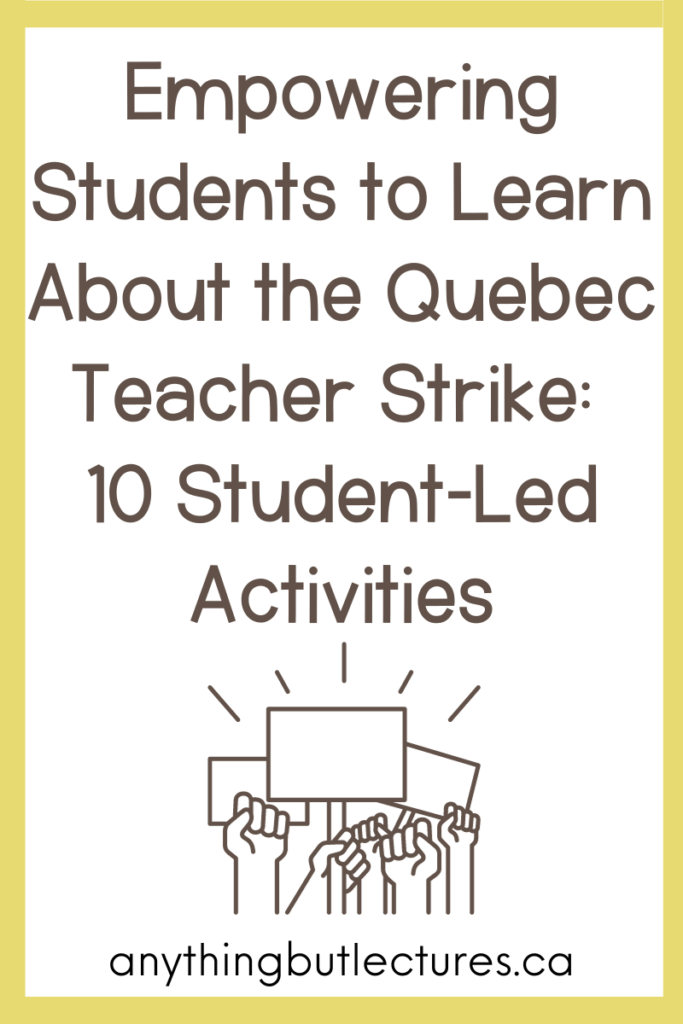A teacher strike does not only affect educators and policymakers. They affect students, families, and entire communities. To help students understand the reasons behind teacher strikes and foster critical thinking skills, it’s a good idea to engage them in meaningful discussions and activities.
Keep reading to explore 20 student-led activities that can empower students to learn about the reason teachers strike and perhaps why teachers like you are currently on strike for better outcomes.

Mock Teacher Strike Negotiations:
Simulate teacher-union negotiations in the classroom. This hands-on approach helps students grasp the complexities of the bargaining process and the challenges involved.
Procedure:
- Select the Setting: Divide the class into two groups, one representing teachers or the union, and the other representing school administrators or the school board.
- Choose a Scenario: Decide on a hypothetical scenario related to teacher contract negotiations. For example, the scenario could involve issues like salary increases, class size, working conditions, or professional development.
- Prepare the Teams: Assign roles to students within each group. Each team should have a leader or spokesperson to facilitate the negotiations. Research materials related to the chosen scenario should be provided to each team.
- Role-Play: The two groups will engage in role-playing, taking on the roles of the negotiating parties. They will need to discuss and negotiate the terms of a contract agreement.
- Negotiation Sessions: Set a series of negotiation sessions over a span of several class periods. During these sessions, students representing the teachers’ side may demand higher salaries and smaller class sizes, while the administrators’ team may focus on budget constraints and maintaining educational quality.
- Mediation and Compromise: Introduce a mediator or neutral party to help resolve disputes and encourage compromise. This mediator could be the teacher or another student playing a neutral role.
- Document Agreements: Have students keep records of the agreements reached during each negotiation session, ensuring that all parties understand the compromises made.
- Debriefing: After the negotiations conclude, hold a debriefing session to discuss what students learned from the exercise. Encourage students to reflect on the challenges, the importance of communication, and the difficulties of finding common ground.
Examples:
- Scenario 1 – Salary Negotiations: In this scenario, teachers are demanding higher salaries due to rising living costs and their commitment to providing quality education. Administrators argue that the budget is tight and needs to be allocated efficiently. Students, representing both sides, negotiate over how to balance these conflicting interests.
- Scenario 2 – Class Size: Teachers express concerns about overcrowded classrooms and its impact on effective teaching, while administrators are concerned about budget constraints. Students must negotiate class size limits and staffing to address these issues.
- Scenario 3 – Professional Development: Teachers want increased professional development opportunities to enhance their skills and stay current with educational trends. Administrators argue for cost-effective solutions. Students in this scenario work on finding a balance that benefits both parties.
By engaging in these mock negotiations, students gain firsthand experience in understanding the challenges faced by teachers and administrators during contract negotiations. This activity provides them with valuable insights into the complexities of collective bargaining and the need for compromise in resolving labour disputes.
Guest Speakers:
Invite teachers or union representatives to share their experiences and reasons for striking. Hearing directly from those involved can provide valuable insights.
Historical Analysis:
Examine past teacher strikes to understand the historical context and reasons behind them. This historical perspective can shed light on the evolution of teacher labor movements.
Objective: Study past teacher strikes to understand the historical context and reasons behind them, allowing students to recognize patterns, causes, and the evolution of labor movements in education.
Procedure:
- Select Historical Strikes: Choose several historical teacher strikes that had a significant impact on education or labour rights. You can focus on strikes from different eras, regions, or with varying outcomes.
- Research Materials: Provide students with resources such as articles, documentaries, primary source documents, and interviews related to the selected teacher strikes. These materials can include news articles, photographs, videos, and firsthand accounts.
- Analyze and Discuss: Divide students into groups and assign each group a specific historical strike to research. Students should analyze the circumstances leading to the strike, the demands made by the teachers or the union, and the response of school boards, administrators, and government authorities.
- Presentation Preparation: Instruct each group to prepare a presentation summarizing their findings. They should discuss the historical context, key events, the role of unions, public support, and the eventual resolution of the strike.
- Class Presentations: Allow each group to present their findings to the class. Encourage discussion and questions after each presentation.
- Comparative Analysis: After all presentations are complete, facilitate a class discussion on common themes, differences, and lessons learned from the historical strikes. Encourage students to identify patterns and understand how teacher strikes have evolved over time.
Examples:
By analyzing historical teacher strikes, students can gain a deeper understanding of the factors that drive these labour actions and the ways in which they have shaped education policy and labour movements over time. This activity encourages critical thinking and historical perspective while shedding light on the evolution of teacher strikes.
Classroom Discussions on Teacher Strikes:
Foster open dialogues about the issues that lead to strikes. Encourage students to express their thoughts, ask questions, and engage in respectful debates.

Letter Writing Campaign:
Encourage students to write letters to school boards or government officials expressing their views on teacher strikes. This activity helps them understand civic engagement and advocacy.
Multimedia Presentations:
Challenge students to create videos or presentations explaining the reasons behind teacher strikes. This allows them to use technology to convey information creatively.
Research Projects:
Assign individual or group research projects on specific teacher strike cases. This activity deepens their understanding of real-world examples.
Mock Teacher Strike News Reports:
Students can script and perform news reports on fictional teacher strike scenarios. This activity enhances their storytelling and journalism skills.
Teacher Strike Case Studies:
Analyze specific teacher strikes, their causes, and the resulting changes in education. This in-depth exploration of individual cases provides insight into the unique challenges faced.
Policy Proposals:
Challenge students to develop their own policy proposals to address the underlying issues that lead to strikes. This empowers them to think critically and propose solutions.
Final Thoughts on Teaching Students About a Teacher Strike…
Engaging students in activities that explore teacher strikes is a valuable educational opportunity. These 20 student-led activities can help young learners understand the complexities of teacher strikes, the challenges faced by educators, and the broader issues in education. By encouraging them to actively participate and think critically, we can empower the next generation to be informed and engaged citizens.
Check out these related blog posts:




